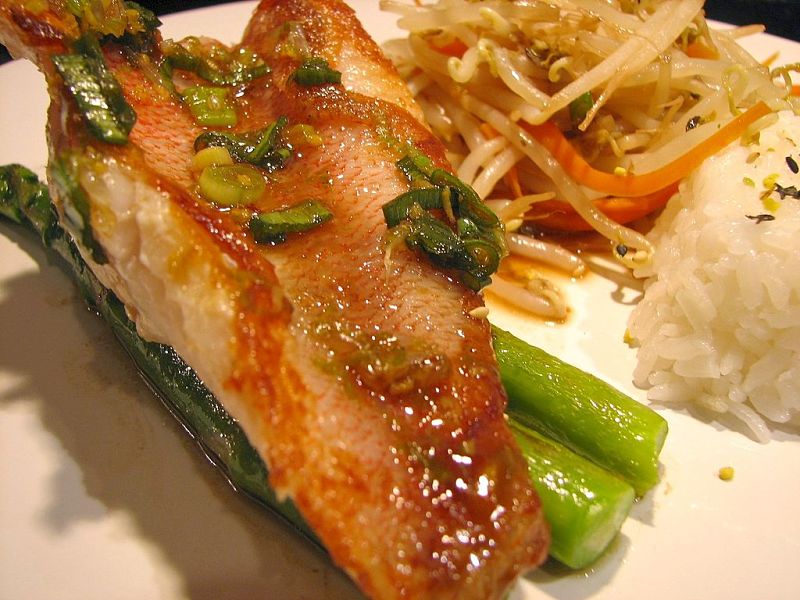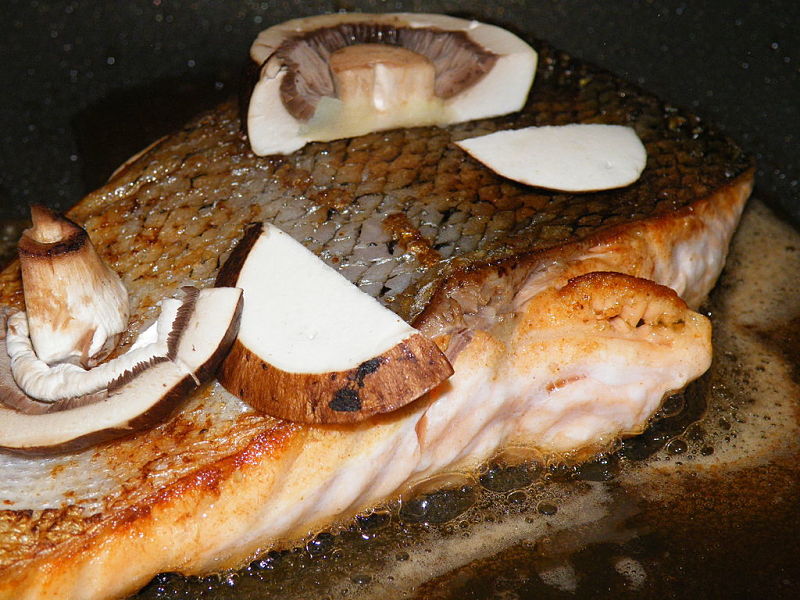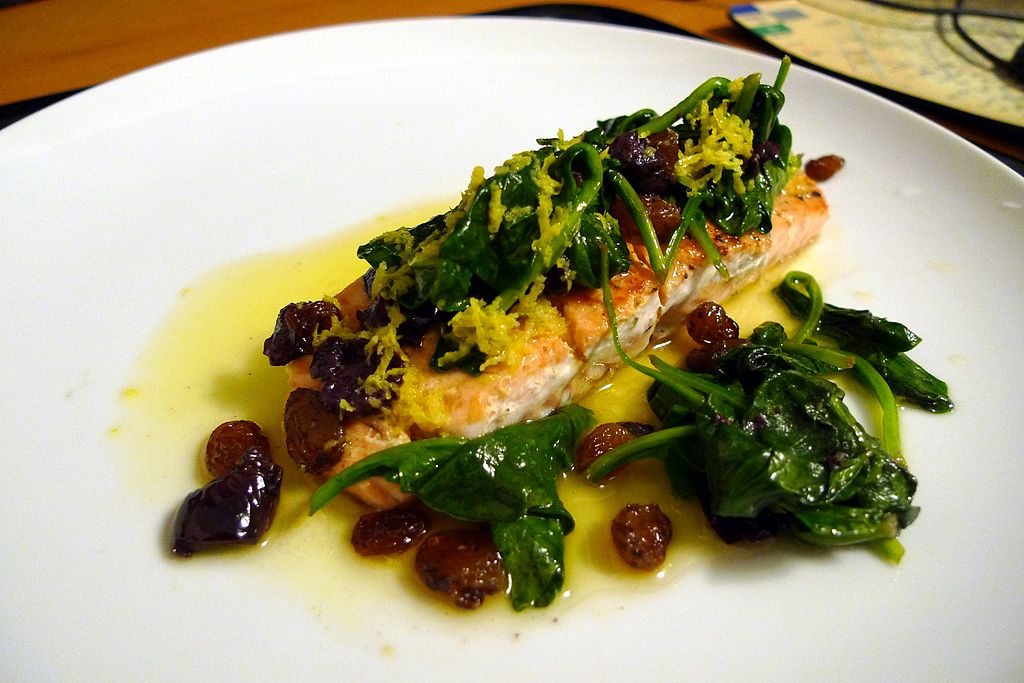Best Pan Seared Fish Recipes - Tuna, Swordfish, Cod, Salmon, Mackerel
There is nothing quite like a perfectly seared piece of fish: Crispy and smoky on the outside and just barely cooked on the inside. It is much like a pan seared piece of steak.
You can use all sorts of pepper and spicy rubs to add flavor without ruining the taste of the fish. No more soggy, fat riddled fried fish of battered fish that is so hard to cook.
Pan seared fish is quick, easy and is very simple to do. However, it works best with large fish steaks or fillets of fish with firm white flesh such as tuna, swordfish, cod and salmon.
You also need to be prepared to eat the fish, virtually raw in the center, and this suits some fish better than others.
Don't try it with flounder or sole or small fish fillets as they will disintegrate and get overcooked and ruined on the hot smoky pan. It can be done but, it requires a lot of effort.
See great tips and recipes for Pan-Seared fish.
Tips for Cooking Pan-Seared Fish
► Skin on or skin off? There is a lot of debate about this. It depends on the dish and your preferences. Some like it, others don't. It does not really matter. If fact the skin usually pulls away after the fish is cooked and you can leave the choice to the individual diner.
► Pan searing works on any thick fillet or fish steak. Smaller fish have a lot of bones and tend to disintegrate, but you can even pan sear very small fish if you take a lot of care.
► Scale and wash the fish thoroughly, but dry it to remove excess moisture. Also chose very fresh fish especially if you are going to eat the center, virtually as raw fish.
► Use a heavy pan and get it very hot before adding a tiny amount of oil. Choose a neutral tasting oil such as rice bran oil, grape seed oil that has a very high smoke point. Don't use olive oil as it will burn and break down when heated to the very high temperatures required. Peanut oil has a high smoke temperature, but it has a strong taste. Only use a tiny amount of oil, especially with the oily fish.
► Heat the pan to a very high temperature. Then add a tiny amount of oil and heat until it shows signs of being ready to smoke. Then add the fish pieces in batches, being careful not to swamp the pan and cause the temperature to drop.
► Bring the fish to room temperature before searing. Cooking fillets straight from the fridge will mean that the center may still be cold when the fish is cooked!
► The choice of the rub or coating you are going to use on the outside of the fish partially depends on how rare you want the inside of the fish to be. If you want the center of the fillets to be partially cooked, the coatings and rubs may burn too much while the fish is being cooked. For rare cooked fish this is not a problem. But for well-cooked fish it may be better to salt the outside of the fish and to wait until the fish is almost cooked before adding pepper and spices onto the surface of the fish. This will stop the coating from burning.
► The pan or skillet you use should be heavy and able to withstand high temperatures. Pans with non-stick polymer coatings are generally unsuitable. Heavy cast pans, ceramic-coated Dutch ovens, stainless steel, and heavy aluminum pans are suitable. The reason for using heavy pans is that you want the pan to store and retain heat so that the temperature does not plunge when you add the fish, otherwise the fish could become oily.
► The skillet must be very hot before adding the fish pieces. Place prepared fish pieces in the hot skillet, with skin side down to start.
Press down gently on fish and add salt and pepper to the upper surface. Press the fish down to stop it curling as it is being cooked. You only want to turn the fish once. the only exception is when you want to add spices and pepper late in the cooking process to stop it burning.
Do not turn or move the fish in the pan until a crust has formed. You will know when it is ready when a crust has formed and the fish will slide over the surface when the pan is shaken or angled to one side. Flip over the pieces of fish over and cook the other side.
► The best place to stored cooked fillets while others are being cooked is on a wire rack placed in a shallow pan in a moderate oven. This keeps the outside of the fish crisps and dry.
► Don't mess about with the fillets - only turn once.
► Look at the side of the fillet to check how the inside of the fish is cooking. Remember that fish cooks very quickly and a hot piece of fish will keep on cooking after it has been removed from the pan. So always err on the side of under-cooking the fish. You definitely don't want it overcooked inside! .
► Serve the prettiest side of the fish face up. If your guests want to eat the skin, then serve the fillet skin-side up. Otherwise serve skin-side down and your diners can remove the fish from the skin as they eat it.
► Finally, if you are going to serve the fish with a sauce, don't pour it over the top and ruin your seared creation. Add the sauce beside the fish or even underneath the fish. When you have gone to all this work for a nice sear, put your sauce underneath the fish. Putting it on top will ruin it.
Pan-Seared Fish Recipes
Basic Pan Seared Fish Recipe
- 1 tablespoon butter
- Lemon or limes for garnish
- 2 tablespoons grape seed, rice bran oil or peanut oil, or clarified butter
- 4 thick fish steaks, fillets, or cutlets, scaled washed and dried (1.5 lb; 3 kg)
- Salt
- Fresh herbs for garnishing
Remove the fish pieces form the refrigerator about 20-30 minutes before cooking to allow them to come to room temperature. Scrape the skin hard with a metal scapula to remove excess moisture (this helps to ensure the skin is crisp when cooked). Then dry the fish pieces on paper towels and sprinkle with salt.
Place a heavy cast-iron or steel pan on a high temperature setting and heat for 3-5 minutes and then add the oil and heat for a further minute. The pan needs to be very hot.
Place the fish pieces in batches of 2-3 (depending on the size) skin side down. Jiggle the fish immediately to stop the fish from sticking to the pan. Add salt and freshly ground pepper to the top side of the fish. As it cooks press down with a spatula to stop the fish from curling. Cook the fish for 2-7 minutes depending on how raw you want the inside to be. For longer cooking lower the temperature to moderate-high.
Keep cooking until the fillet slides easily. Then flip the fillet over and cook for 2-5 minutes on the other side. Add a tablespoon of butter to the pan for drier types of fish. Serve with lemon and lime slices, fresh herbs such as coriander and a homemade sauce or relish.
Pan Seared Fish Recipe with Salt, Lemon and Paprika Rub
- 1 cup whole wheat flour or cornmeal
- sea salt and freshly ground pepper
- 1 tablespoon of paprika
- 1 tablespoon of mixed dried herbs or spices (your choice)
- Zest and juice of one lemon or lime
- 4-6 pieces (about 2 lb; 1kg in total) of firm white-fleshed fish (fillets or steaks)
- 1 tablespoon rice bran oil or grape seed oil
- 2 tablespoons butter
Mix together the salt, flour, pepper, paprika, herb, spices and lemon zest in a flat bowl. Add the fish pieces to the mixture one at a time and rub it into all parts of the fish. Shake to remove excess. Heat a heavy pan on high heat, add the oil and heat again for 2 minutes. The pan should be very hot. Cook the fish in batches or 1-3 pieces so they will brown evenly and quickly. Only flip once. Cook to your desired taste. When cooked, quickly add some lemon juice and a tiny piece of butter to the pan and swirl around the pan. The lemon will sizzle and add to the coating on the fish. Serve immediately.


